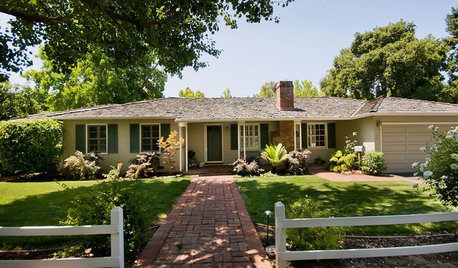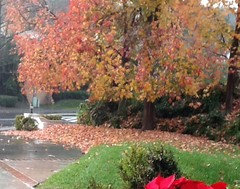Bradford...yes! But in So. Ca.??
martinca_gw sunset zone 24
8 years ago
Featured Answer
Comments (34)
parker25mv
8 years agolast modified: 8 years agoedlincoln
8 years agolast modified: 8 years agoRelated Discussions
So many problems... so little time in CA
Comments (3)You may have better luck in your second year. I'm a big advocate of planting over grass, as it will compost down and create rich soil. But it's always best to give it several months to decompose before planting. I probably would have gone 2' wide at a minimum, though I don't know how much the narrow width will hinder your garden. I'm in agreement that your wilting is most likely heat. That temp is awfully hot for new plants. If they're turning yellow and wilting, they're getting too much water. If they're staying green and wilting, they're not getting enough water. I always give my plants extra water when the temps go over 90 like they have this week....See MoreNeed ID: Yellow flowers blooming in So CA (Santa Monica)
Comments (4)In Santa Monica it is most likelyAchillea 'Moonshine'...See MoreWhere to get bulbs for so ca
Comments (12)I've got three boxes of bulbs on my dining table right now! I can't help but order when they first become available, then I'll order a few more from elsewhere, then the sales start to wrap up the season and I can't help it there's a third order! Then spring bulb pre-orders have already started...?!? Easy to Grow Bulbs used to be my favorite, but they've disappointed me more and more lately. Plus shipping is too much, and you have to order $125 for free shipping... Feels silly when I live 15 minutes from them. Longfield Gardens sells slightly smaller bulbs, but is way cheaper and offers free shipping at only $50 order. Their range is a little more limited, too, but if they have what you want I wouldn't hesitate to recommend them. Then there's always Brent & Becky's... Bulb madness!!!...See MoreAnyone in So Ca near the San Fernando valley want pumpkins?
Comments (1)A pity you're my neighbour....See Morewisconsitom
8 years agoparker25mv
8 years agolast modified: 8 years agomartinca_gw sunset zone 24
8 years agoparker25mv
8 years agomartinca_gw sunset zone 24
8 years agoEmbothrium
8 years agolast modified: 8 years agomartinca_gw sunset zone 24
8 years agoedlincoln
8 years agoken_adrian Adrian MI cold Z5
8 years agowisconsitom
8 years agolast modified: 8 years agoedlincoln
8 years agolast modified: 8 years agoToronado3800 Zone 6 St Louis
8 years agoRugbyHukr
8 years agowisconsitom
8 years agoedlincoln
8 years agoEmbothrium
8 years agoparker25mv
8 years agolast modified: 8 years agoEmbothrium
8 years agolast modified: 8 years agocampv 8b AZ
8 years agolast modified: 8 years agowisconsitom
8 years agoEmbothrium
8 years agolast modified: 8 years agomartinca_gw sunset zone 24
8 years agomartinca_gw sunset zone 24
8 years agoEmbothrium
8 years agolast modified: 8 years agomartinca_gw sunset zone 24
8 years agocampv 8b AZ
8 years agomartinca_gw sunset zone 24
8 years agoHuggorm
8 years agowisconsitom
8 years ago
Related Stories

GARDENING GUIDESYes, You Can Grow an Edible Garden on a Hot, Dry Site
Difficult garden spots don’t need to deter you from planting trees, herbs and other delicious food plants
Full Story
LIFESo You're Moving In Together: 3 Things to Do First
Before you pick a new place with your honey, plan and prepare to make the experience sweet
Full Story
GARDENING FOR BUTTERFLIES3 Ways Native Plants Make Gardening So Much Better
You probably know about the lower maintenance. But native plants' other benefits go far beyond a little less watering and weeding
Full Story
DECORATING GUIDESNo Neutral Ground? Why the Color Camps Are So Opinionated
Can't we all just get along when it comes to color versus neutrals?
Full Story
DECORATING GUIDESSo Your Style Is: French Country
With an artful balance between earthy and chic, French country style infuses a home with incomparable warmth and welcome
Full Story
DECORATING GUIDESSo Your Style Is: Industrial
With its raw, utilitarian appeal, industrial style gives modern homes a sophisticated edge
Full Story
FLOORSIs Radiant Heating or Cooling Right for You?
Questions to ask before you go for one of these temperature systems in your floors or walls (yes, walls)
Full Story

ARCHITECTURE10 Advantages of the Humble Ranch House
Boomer-friendly and not so big, the common ranch adapts to modern tastes for open plans, outdoor living and midcentury mojo
Full Story
BEDROOMSThe Right Mattress: The Secret to a Great Night’s Sleep
We spend a third of our lives asleep, so investing in a quality mattress is essential. Check out this expert advice to help you choose yours
Full Story






Embothrium